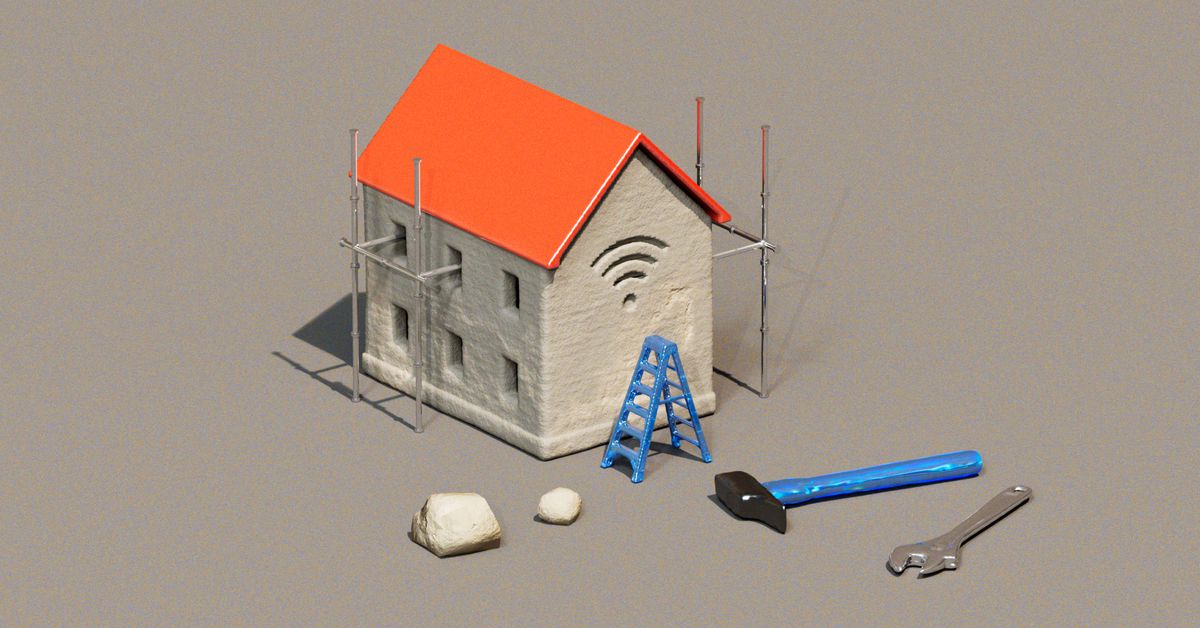/cdn.vox-cdn.com/uploads/chorus_asset/file/25131750/236836_Infrastructure_HOMEBUILT_INTERNET_Sisi_Kim.jpg.jpg)
Until a couple of months ago, I hadn’t lived in a “smart home” built within the last five years. I was lured in by the availability of symmetrical 1GB fiber internet for the same $100 that got me 500Mbps of asymmetrical cable at my previous apartment. But I encountered more obstacles getting it set up than a track and field hurdler, everything from a missing fiber gateway port to my $1,000 robot vacuum losing connection every time it tried to clean too far away from the router. I was saved by the ethernet ports in every room and my off-the-shelf Asus gaming router, but I couldn’t (and still can’t) do anything about the cable Cthulhu monstrosity lurking behind a metal plate in my closet that drives most of my frustration.
It turns out that the “smart homes of the future” cannot run on Wi-Fi alone thanks to the materials we’ve been using to construct our homes cheaply and quickly for decades. Over the last several years, more engineering and architecture firms have started including ethernet wiring in their building plans, but that’s as far as the digital infrastructure of a home usually goes. What’s forgotten is not only where the pre-built internet hub is placed inside the building but also what materials are used for construction.
I’m going to use my new home as an example. It was built with an “internet hub.” Every ethernet cable and coax cable threaded through the walls terminates inside a nook because that nook is where cable and fiber enter the house. The ISP’s provided modem / router goes inside the nook and is then covered with a wobbly metal plate that gets screwed into the wall at the corners.
The Information Technology and Innovation Foundation (ITIF) noted in a recent blog post that if the US were to focus a significant chunk of its efforts on creating a better digital infrastructure instead of “fixing” our physical infrastructure, it would result in “superior longer-term economic growth, competitiveness, national security, and environmental benefits.” This includes outfitting buildings and dwellings with wired Gigabit fiber internet and, more importantly, taking into consideration which materials would obstruct Wi-Fi signals the least.
A plethora of architects, civil engineers, and project managers across Orange and Los Angeles counties in California all told me the same thing: Wi-Fi-penetrating materials typically aren’t a consideration unless it’s a large structure like an office building or warehouse; telecom technicians are called in then, but mainly to help with wiring. However, those same people told me they’ve been able to reduce construction costs significantly by wiring residences for ethernet as they are building them.
The cost of common building materials like brick, wood, drywall, plywood, concrete, metal, and acoustic ceiling tiles is usually cheaper than Wi-Fi-penetrating materials, especially if they are sustainable — although the cost of even common materials has sharply increased by 20.4 percent year over year as of April 2022, according to the National Association of Home Builders (NAHB). With many states in the middle of a severe housing crisis driven in part by those rising material costs, it’s likely many companies will continue to build for speed. California, for example, needs 2.5 million new, affordable homes, and at least 1 million of those must be for low-income families or those experiencing houselessness.
As for older buildings, a recent study published by several members of the Institute of Electrical and Electronics Engineers, or IEEE, mentions that wireless signals running on mmWave (millimeter wave) or high-frequency bands like Verizon’s 5G home internet have worse “penetration loss” when the signal is being received from outside. Depending on which wave band is being used and what materials are on the outside of the building, that penetration loss can be severe to the point where the Wi-Fi signal can only penetrate a single room.
With cost reductions and speed currently at the forefront of many building projects, this puts the burden on the people living there to diagnose their own Wi-Fi issues and adds to the overall cost of getting internet set up in a home. And look, that’s no different than what many of us have been doing over the last couple of decades, but not everyone has the technical know-how or the extra cash to do it.
DIY-ing your own ethernet installation can cost several hundred dollars for the equipment alone. But even if you watch a bunch of YouTube videos and are confident you can do it yourself, and have convinced your landlord you can do it (assuming they even entertain the idea in the first place), that’s not the same as actually doing it. The other alternative is paying a professional thousands of dollars to wire your place with a few Cat 5 cables. (Preferably better than the setup built into my apartment.)
I have the privilege of knowing how to troubleshoot this stuff on my own largely due to my profession as a tech journalist. To others, this stuff is a foreign language. Knowing how to set up a home internet system is not a skill everyone has, and the complicated steps required to do it properly make moving to a new place more stressful, especially if you work remotely and need the internet to earn a paycheck.
If we don’t want our homes to eat Wi-Fi signals, companies will need to start eating the cost of choosing better Wi-Fi-penetrating materials — or, at the very least, they will need to stop putting fiber connection points literally inside walls.
Services Marketplace – Listings, Bookings & Reviews
